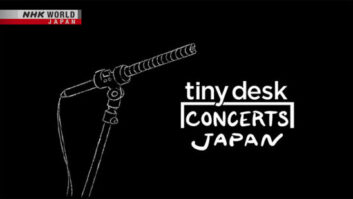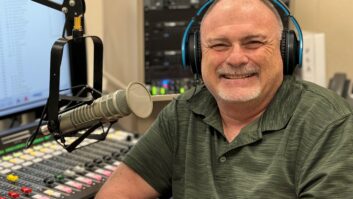
NPR Distribution Director of Operations & Engineering Dick Kohles delivers last-minute instructions to NOC operators moments before the ContentDepot live streams carrier was uplinked for the first time from the new PRSS NOC at 1111 North Capitol Street NE in Washington.
Credit: Photos by Bruce Wahl, NPR
WASHINGTON — One of the first groups of staffers to move into NPR’s new $201 million headquarters nine blocks north of the Capitol were those of its Distribution Division, which manages the Public Radio Satellite System.
The new headquarters was designed to accommodate NPR’s evolution from a radio broadcaster to a multimedia operation, according to the organization. Key features include a two-story newsroom where news, music and digital staff work together, and a 250-seat performance studio. Studios were designed with public viewing areas.
More than three and a half years of planning went into the Distribution Division move. The PRSS disseminates programming to approximately 1,600 public radio stations; its ContentDepot distribution system streamlines how public radio producers deliver their programming and how stations receive it.
ContentDepot uses satellite technology for its primary delivery platform; it replaces real-time audio feeds of programs to stations with Internet protocol streams and file transfer of pre-recorded programs. The ContentDepot also uses the Internet to deliver pre-recorded program files to stations that are unable to receive programming via satellite. Its Web-based program subscription service and enhanced automation give stations more flexibility in the ways they receive programs from the PRSS, according to NPR.
Distribution Director of Operations & Engineering Dick Kohles said the transition of the PRSS Network Operations Center from 635 Massachusetts Avenue to the new location at 1111 North Capitol Street went smoothly. “In general, it was a very good transition. We planned carefully and had a great many people involved.”
He said roughly 50 technical people at NPR worked 12 hours a day, including weekends for many of them, for six weeks to ensure that stations served by the PRSS continued to receive their satellite- and Internet-distributed programming.
The NOC is the heart of the PRSS. The new NOC includes Axia head-ends and other computer equipment for monitoring the system. It also features a video wall — a dashboard showing the status of key system functions.
Another unique feature of the new NOC is the “egg chair.” A NOC tech seated in the chair is able to monitor incoming programming from an acoustically-isolated environment while at the same time keep track of what’s happening on the video wall.
The rest of the PRSS equipment is on the second floor of the former C&P warehouse portion as part of a “tech core” located behind the NOC. The PRSS shares this room with NPR IT and Audio Engineering. It contains the PRSS’ satellite uplinking and downlinking gear, encoders and ContentDepot servers.
Placing much of the equipment in what NPR thinks of as a huge data center allows the AC environment to be controlled more economically, Kohles said.
NPR Distribution engineers built the first iteration of the new NOC in the annex of the old Massachusetts Avenue building. They made sure it was functional. They then tested the equipment, disassembled it and shipped the equipment to the new location a few blocks away in October. There, the Distribution team rebuilt and reassembled the system, including integrating other services, finally locating the system in its new location.
They activated the North Capitol Street satellite uplink on Monday, April 1, beginning with the ContentDepot program file carrier, at 12:40 p.m. Eastern, followed by the ContentDepot live program streams carrier, at 12:59 p.m. Eastern. NPR President/CEO Gary Knell threw the symbolic switch to transmit live broadcast programming from the new location, beginning with the top-of-the-hour NPR newscast.
The PRSS has one satellite uplink in Washington and a backup in St. Paul.

A NOC tech seated in the ‘egg’ chair is able to monitor incoming programming from an acoustically-isolated environment while at the same time keep track of what’s happening on the video wall. Ralph Woods, NPR Distribution, is shown in the chair.
Credit: Photo by Dick Kohles, NPR The team had installed circuits between the old and new buildings. If there were problems, the fallback plan was to continue to originate programming from Massachusetts Avenue, and a third option was to go to the PRSS back-up NOC at Minnesota Public Radio in St. Paul, Minn. Neither was necessary, according to Kohles.
A HUGE DATA CENTER
The new NPR headquarters totals 440, 000 square feet of space.
In its new location, NPR “married” a former C&P Telephone warehouse that has a historic designation to a new, attached seven-floor building. The PRSS satellite dishes are on the roof of the old four-floor warehouse, Kohles said, to shield them from interference, among other reasons.
To coincide with the move, PRSS customers, including NPR member stations, migrated last fall from legacy IDC SR2000pro satellite receivers (for streams) and SFX2100 receivers (for files) to new IDC SFX 4104 Pro Audio receivers. The new receivers combine a four-port stream decoder with a file receiver in one unit.
One good thing about the new location, Kohles said is now all Distribution employees can be in the same location; previously they were in NPR’s former headquarters and another nearby building. “This way we get to work together physically” without needing to arrange formal meetings, he said.












